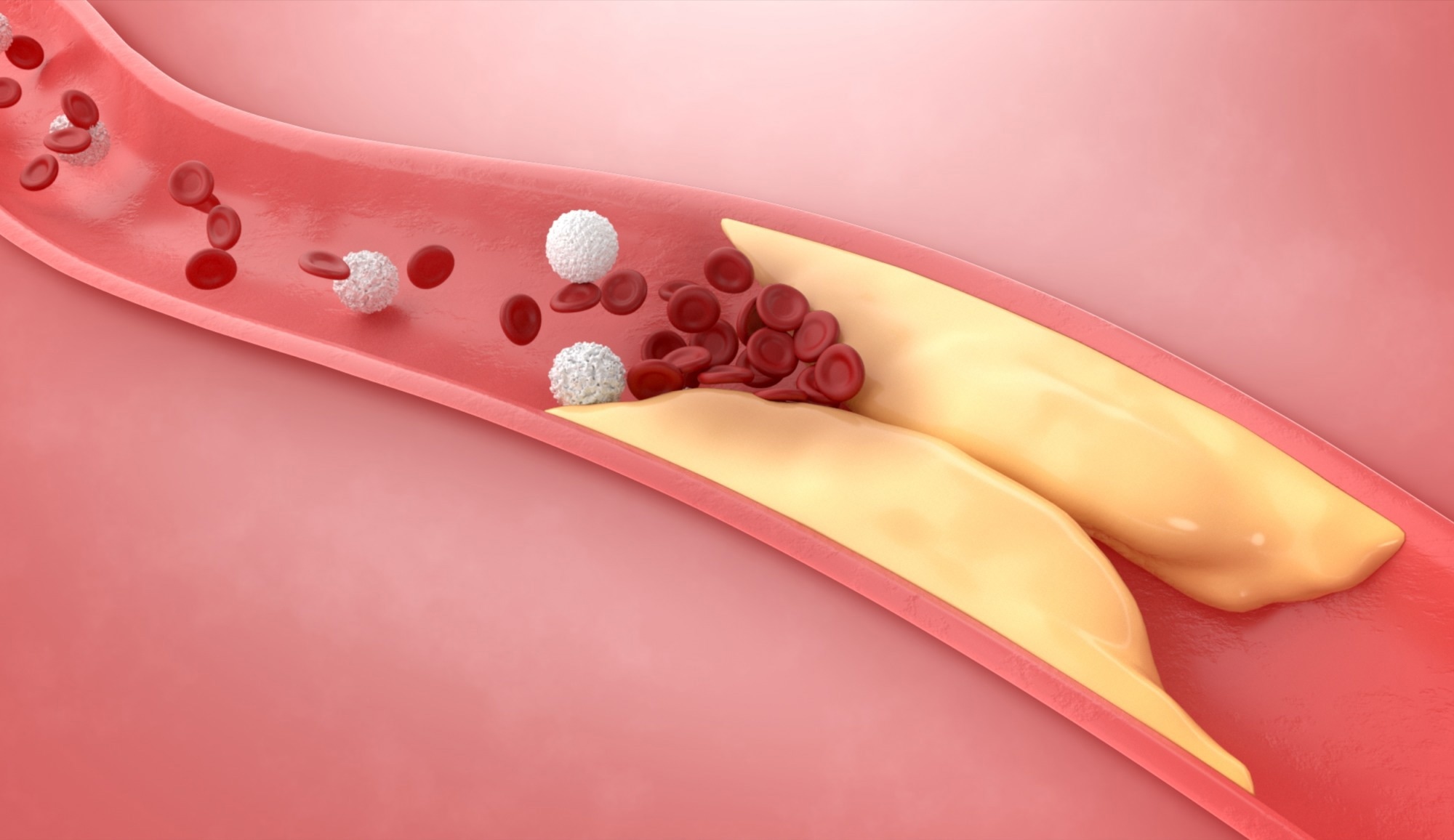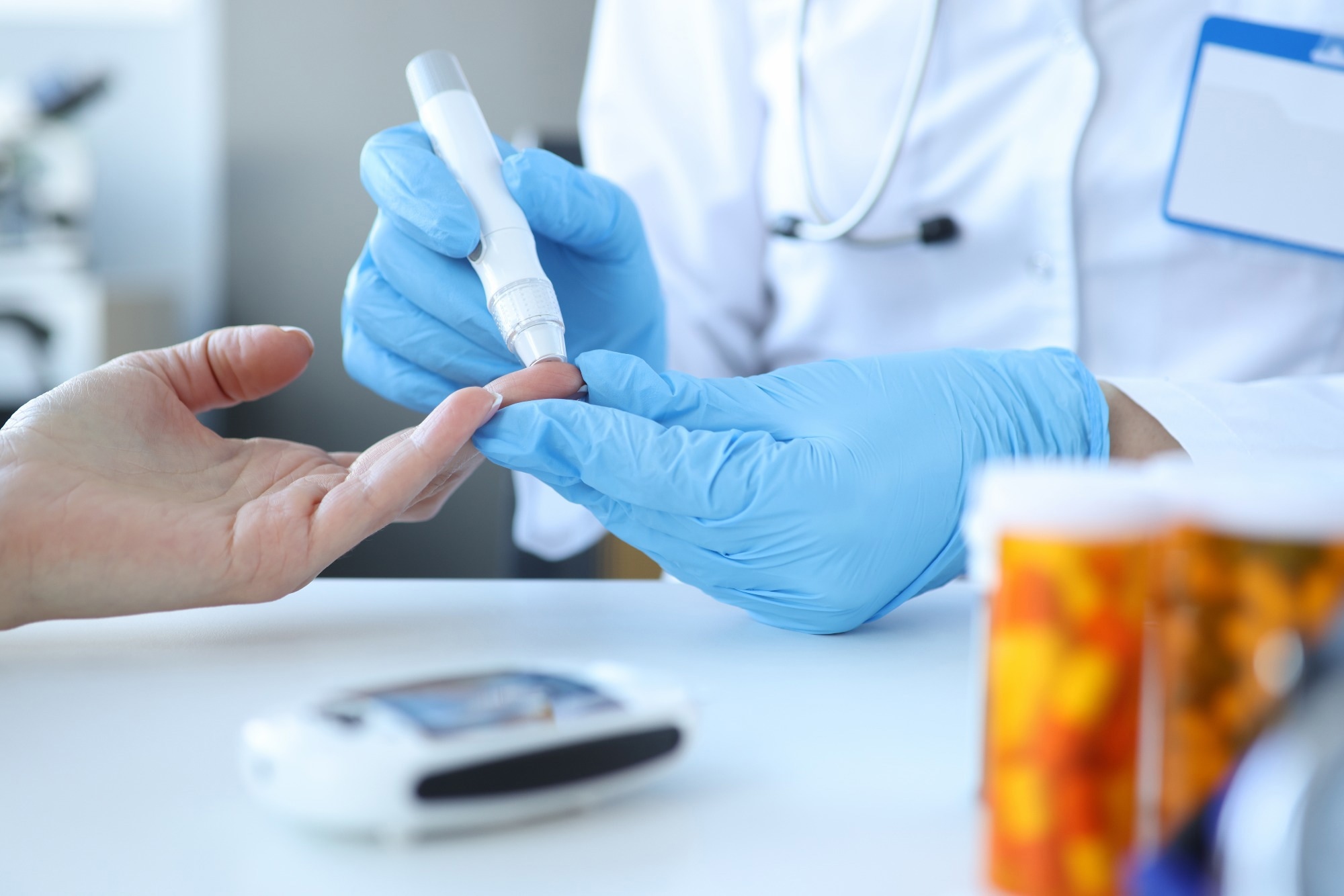Low-density lipoproteins (LDLs)
PCSK9 gene
Therapeutic strategies
Inclisiran
References
Further reading
High levels of low-density lipoprotein (LDL) cholesterol can cause artery blockages and diseases like heart attacks and strokes. Further, it raises the risk of cardiovascular disease (CVD).
 Thickened arteries and veins with cholesterol. Image Credit: NPW-STUDIO/Shutterstock.com
Thickened arteries and veins with cholesterol. Image Credit: NPW-STUDIO/Shutterstock.com
Although medicine and lifestyle modifications can considerably lower LDL, a considerable portion of at-risk individuals who are receiving therapy nevertheless experience a cardiovascular event.
Vaccines targeting proprotein convertase subtilisin/kexin 9 (PCSK9), an important regulator of LDL receptors, can be highly beneficial.
Low-density lipoproteins (LDLs)
There are five main forms of lipoprotein that transport cholesterol in the body's aqueous extracellular environment. The primary organ for the metabolism of cholesterol and control of plasma cholesterol levels is the liver.
When the liver repackages intrahepatic cholesterol into very low-density lipoprotein (VLDL), either through de novo synthesis or gut absorption, the process of LDL production starts.
Once in the bloodstream, VLDL is changed into more cholesterol-rich species, intermediate-density lipoprotein (IDL), and ultimately LDL, by the enzymes lipoprotein lipase and cholesteryl ester transfer protein (CETP). By clearing them through LDL receptors on the hepatic surface, the liver predominantly controls the quantity of these circulating lipoprotein types.
LDL receptors (LDL-R), highly expressed in hepatocytes, interact with LDL in plasma to remove it from circulation. LDL is endocytosed and undergoes lysosomal degradation as a result of LDL-R binding. LDL-R is then recycled back to the cell surface after this procedure.
Circulating LDL particles can pass through the endothelium of artery walls, where they can oxidize, cause inflammation, and damage the adjacent smooth muscle cells and overlaying endothelium.
PCSK9 gene
PCSK gene forms a protein that helps control the quantity of cholesterol in the bloodstream. The body produces cholesterol, a waxy, fatty molecule, and it can also be consumed through foods that contain animals.
The quantity of low-density lipoprotein receptors, which are proteins on the surface of cells, is regulated by the PCSK9 protein. These receptors are essential for controlling the amount of cholesterol in the circulation.
Low-density lipoproteins (LDLs), the main transporters of cholesterol in the blood, attach to the receptors. The liver, which removes the majority of extra cholesterol from the body, contains a lot of low-density lipoprotein receptors.
The rate at which cholesterol is eliminated from the bloodstream depends on the quantity of low-density lipoprotein receptors on the surface of liver cells. More cholesterol can stay in the bloodstream because the PCSK9 protein destroys low-density lipoprotein receptors before they reach the cell surface.
 Cholesterol testing. Image Credit: megaflopp/Shutterstock.com
Cholesterol testing. Image Credit: megaflopp/Shutterstock.com
Therapeutic strategies
The finding that the LDL receptor is encouraged to degrade by the PCSK9 opened up a new method for regulating plasma LDL cholesterol levels. Monoclonal antibodies were the mainstay of the initial therapeutic strategies to lower PCSK9 levels in circulation.
Alirocumab, evolocumab, and inclisiran are three pharmaceuticals that can lower PCSK9 activity and are offered in the US. Fully humanized monoclonal antibodies that are injected subcutaneously every 2 to 4 weeks, alirocumab and evolocumab, are very effective at reducing both total and LDL cholesterol.
They typically lower LDL cholesterol levels by 50% to 60%, whether used as monotherapy or in conjunction with a statin. As long as the treatment is given, the effect lasts.
FDA-approved bempedoic acid, a non-statin medication, lowers LDLc by blocking ATP citrate lyase, a crucial enzyme in the process that produces cholesterol. It is administered to patients in the US who have established atherosclerotic cardiovascular disease or heterozygous familial hypercholesterolemia.
Another oral chemical, gemcabene calcium, has been tested in rat experiments for its lipid-lowering actions that are not dependent on PPARs (peroxisome proliferator-activated receptor alpha). In male rats, this chemical reduced LDLc, TG, and apolipoprotein C-III levels. It is currently being researched.
Inclisiran
A small interfering RNA (siRNA) called inclisiran prevents PCSK9 from being synthesized inside cells. When given to people taking the highest dosage of a statin, inclisiran cuts LDL cholesterol by 50%.
In one study, two doses of 284 mg of inclisiran, or 300 mg of inclisiran sodium, given on days 1 and 90, resulted in a 52.6% reduction in LDL cholesterol at 180 days.
Data from the same trial followed the same patients for 360 days. It was revealed that inclisiran might offer long-lasting reductions in LDL cholesterol levels, with the possibility of a once-every-six-month treatment regimen.
In another study, patients with atherosclerotic cardiovascular disease (ORION-10 trial) and those with atherosclerotic cardiovascular disease or an atherosclerotic cardiovascular disease risk equivalent were enrolled in a trial. Patients were also enrolled in the ORION-10 trial. Even though they were taking statin medication at the maximum tolerable dose, their LDL cholesterol levels were increased. A subcutaneous injection of inclisiran (284 mg) or a placebo was given to patients randomly in a 1:1 ratio on day 1, day 90, and then every six months for a total of 540 days.
There were two coprimary endpoints in each trial. First was the placebo-corrected percentage change in LDL cholesterol level from baseline to 510th day. Second was the time-adjusted percentage change in LDL cholesterol level from baseline after day 90 and up to day 540.
Although injection-site adverse events were more frequent with inclisiran than with placebo, the reactions were typically mild, and none were severe or persistent. Overall, adverse events were comparable between the inclisiran and placebo groups in each trial.
With inclisiran, given subcutaneously every six months, LDL cholesterol levels were reduced by about 50%. According to the investigation, inclisiran can be dosed sparingly to achieve long-lasting drops in LDL cholesterol levels.
Further understanding of the LDL mechanism and the trial of different therapeutic agents in patients can add to the existing therapy.
References
- Pokhrel B, Yuet WC, Levine SN (2023). PCSK9 Inhibitors. [Updated 2022 May 13]. In: StatPearls [Internet]. Treasure Island (FL): StatPearls Publishing. Available from: https://www.ncbi.nlm.nih.gov/books/NBK448100/
- Ray KK, Wright RS, Kallend D, Koenig W, Leiter LA, Raal FJ, Bisch JA, Richardson T, Jaros M, Wijngaard PLJ, Kastelein JJP. (2020). ORION-10 and ORION-11 Investigators. Two Phase 3 Trials of Inclisiran in Patients with Elevated LDL Cholesterol. N Engl J Med. Apr 16;382(16):1507-1519. doi: 10.1056/NEJMoa1912387.
- Crismaru I, Pantea Stoian A, Bratu OG, Gaman MA, Stanescu AMA, Bacalbasa N, Diaconu CC (2020). Low-density lipoprotein cholesterol lowering treatment: the current approach. Lipids Health Dis. May 6;19(1):85. doi: 10.1186/s12944-020-01275-x.
- Ray KK, Landmesser U, Leiter LA, Kallend D, Dufour R, Karakas M, Hall T, Troquay RP, Turner T, Visseren FL, Wijngaard P, Wright RS, Kastelein JJ (2017). Inclisiran in Patients at High Cardiovascular Risk with Elevated LDL Cholesterol. N Engl J Med. Apr 13;376(15):1430-1440. doi: 10.1056/NEJMoa1615758.
- Pan Y, Zhou Y, Wu H, Chen X, Hu X, Zhang H, Zhou Z, Qiu Z, Liao Y. (2017). A Therapeutic Peptide Vaccine Against PCSK9. Sci Rep. Oct 2;7(1):12534. doi: 10.1038/s41598-017-13069-w.
- Wadhera RK, Steen DL, Khan I, Giugliano RP, Foody JM (2016). A review of low-density lipoprotein cholesterol, treatment strategies, and its impact on cardiovascular disease morbidity and mortality. J Clin Lipidol. May-Jun;10(3):472-89. doi: 10.1016/j.jacl.2015.11.010.
- Crossey E, Amar MJA, Sampson M, Peabody J, Schiller JT, Chackerian B, Remaley AT (2015). A cholesterol-lowering VLP vaccine that targets PCSK9. Vaccine. Oct 26;33(43):5747-5755. doi: 10.1016/j.vaccine.2015.09.044.
- PCSK9 gene. [Online]. Medline Plus. Available at: https://medlineplus.gov/genetics/gene/pcsk9/
Further Reading
Last Updated: Jul 24, 2023